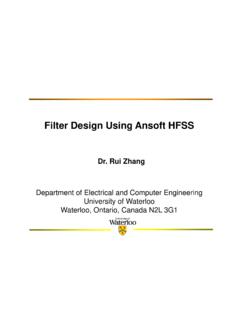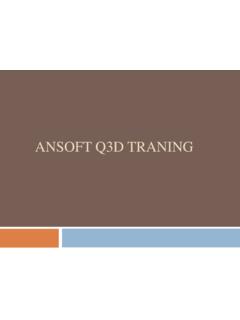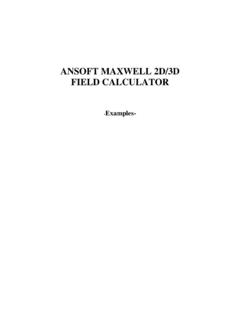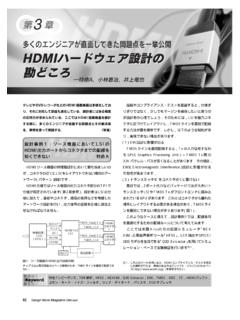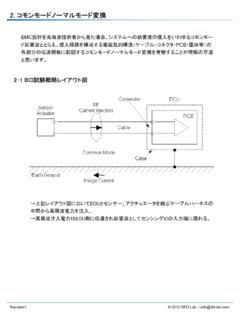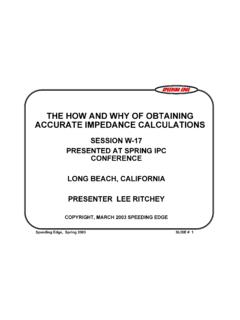Transcription of Synthesis and Analysis of Microstrip and Stripline ...
1 SYRACUSE UNIVERSITY. Synthesis and Analysis of Microstrip and Stripline Transmission line Structures Project 1. Colin Robinson Thomas Piwtorak Bashir Souid 10/18/2011. Abstract The methodologies for computer calculation of transmission line parameters are studied and formulated into a MATLAB based tool. Transmission line structures of Microstrip as Stripline are considered. The approach of both Synthesis and Analysis are formulated for both structure types, and a graphical user interface (GUI) tool is constructed using Matlab. Table of Contents Abstract .. 2. Introduction .. 4. Graphical User Interface (GUI) .. 4. Equations .. 5. Stripline .. 5. Analysis .. 6. Synthesis .. 8. 10. Analysis .. 11. Synthesis .. 13. Frequency Dependence .. 14. Comparison to Industry Software .. 17. Microstrip Comparison.
2 17. Analysis .. 17. Synthesis .. 20. Stripline .. 22. Analysis .. 22. Synthesis .. 24. Conclusion .. 26. Bibliography .. 27. Introduction This report presents an outline for computer calculation of transmission line parameters, considering both Microstrip and Stripline structures. The methodologies of such calculations are arranged from various literature sources and formulated into a Matlab-based tool. The approach of both Synthesis and Analysis are formulated for both structure types, and a graphical user interface (GUI) tool is constructed using Matlab. Synthesis pertains to the formulation of transmission line physical width and length dimensions with an input of various parameters including substrate properties, characteristic impedance, electrical length, and frequency. Analysis considers the calculation of characteristic impedance and line electrical length from input of physical width and length, substrate properties, and frequency.
3 The frequency dependence of effective dielectric constant and characteristic impedance is also presented. The results of the presented tool are compared to industry standard microwave structure simulators, Ansoft Designer and Ansoft HFSS, for example Microstrip and Stripline structures. Analysis is compared for all three programs. Synthesis is compared between the provided tool and Designer, as HFSS is strictly an Analysis tool. However, the results of the Synthesis calculations are analyzed in HFSS as a sort-of check Graphical User Interface (GUI). The GUI accepts numerical inputs from the user as well as a selection for Microstrip / Stripline and a command for either Analysis or Synthesis . The numerical inputs can be of a variety of units, selectable from a drop-down window. Substrate parameters of height, relative permittivity (dielectric constant).
4 And loss tangent must be entered, as well as conductor thickness and conductivity. The signal frequency is also a user input. The results of Analysis are characteristic impedance, electrical length, and effective dielectric constant which is sometimes referred to as Keff. The results of Synthesis are width and physical length. Figure 1 Graphical User Interface Main View Equations The main analytical content of the tool is reported below. The programming code to utilize the equations and techniques, as well as formulate the GUI, is attached with the report. Stripline Figure 2 Standard Stripline structure representation Analysis The characteristic impedance calculation of the Stripline transmission line structure is dependent on a ratio of the thickness of the metal to the thickness of the substrate.
5 If the metal thickness is less than 1000th of the height, then the structure is considered to be a thin strip approximation where the thickness is altogether ignored, and the characteristic impedance is calculated as reported by Cohn in Characteristic Impedance of the Shielded-Strip Transmission line . For any thicker signal metallization, a finite strip calculation must be followed. This computation was borrowed from a computer program titled Wcalc written by Dan McMahill, licensed under the GNU. version II, and used with the authors permission. ( ).. Where And ( ). and The electrical length is computed as a ratio of wavelengths, in degrees, as follows;.. The total losses are a combination of the dielectric and conductive losses And can be calculated from;. Or Where and where The conductive losses are much more complicated and utilize an iterative approach, based on the skin depth and wheeler incremental inductance approach, as partly described in Pozar's Microwave Engineering and utilized in the Wcalc code.
6 If the metal thickness is less than three times the skin depth (tmet < 3*skindepth), Wheeler's incremental inductance approach is utilized as such;. Find the characteristic impedance (z1) for the Stripline while assuming r = 1). Find the characteristic impedance (z2) for the Stripline while assuming r = 1, width = (width - skin depth), and metal thickness = (metal thickness skin depth). If (tmet > 0). Otherwise, the thickness is approximated as zero and there are no losses Converting to dB. Accounting for the surface roughness of the material;. ( ). Synthesis Synthesis is the analytical computation of transmission line physical width and length given a characteristic impedance, electrical length, and signal frequency from the user input. A process called bisection steps for synthesizing the width is borrowed from Wcalc, using the Stripline Analysis method described above, and computed as follows.
7 To begin, find the characteristic impedance of the line assuming the width is equal to the height, as used in the Analysis function described above in the Stripline Analysis section. The difference between this impedance and the target impedance is the error value. It is also assumed the maximum value for the width is 100*height and the minimum value of the width is *height. Record if the value is positive (greater than the target) or negative (less than the target). The step size is: For the initial iteration of Synthesis , an assumption is made that the previous width is ( *width), and this new value is used to calculate the previous error value. It is computed in this way so that the initial step size is not a value of zero, as this value is in the denominator. The new width for Synthesis is: If this new width is greater than the maximum width (100*height) or less than the minimum width ( *height), take a bisection step.
8 The tool analyzes the transmission line (as described in the above) using this new width. The new error value is the computed characteristic impedance minus the user-input or target characteristic impedance. The tool will then check if the new characteristic impedance value is above or below the target value. If the sign of the error value is the same as the initial error value, the Analysis has not progressed far enough. If the sign is opposite the initial error value, the Analysis has progressed beyond the target value or has overshot the Analysis . If the Analysis has not progressed far enough, the maximum width is changed to the width used in the previous iteration, since it can be assumed the width needed to produce the target impedance will be less than this value. If the Analysis has overshot the value, then the minimum value is changed to the width used in the previous iteration.
9 This process is repeated to adjust the upper and lower limits of the impedance range. The characteristic impedance error value is set to .00001% of the target. An example of the refinement of calculated width is captured during runtime of the Matlab tool and plotted below. The calculated width begins very large and decreases until the computation has progressed beyond the target value, in which case the corrective action of the Analysis brings the calculated width much closer to the target value in the following iteration. Figure 3 Synthesis of Stripline width, results of computation captured with each iteration Finally, the physical length of the Stripline is computed similarly to the electrical length as described in the Analysis section above. The physical length is computed from the input electrical length and the dielectric constant.
10 Microstrip Unlike the Stripline structure presented above, no research or literature reviewed during the development of this tool considered the metallization parameters (thickness and conductivity) during the derivation of closed-form approximations for Analysis or Synthesis of Microstrip transmission line structures. The relationships are too complex to include in simple closed-form approximations and are better handled by field-computation and moment-method- Analysis tools designed for the microwave industry. Considering this, the computation of the tool as described below does not consider metallization parameters. Figure 4 Standard Microstrip structure Analysis The Microstrip transmission line structure has metallization placed on top of a substrate and exposed to air, and therefore the effective permittivity is a complex relationship between the substrate properties and air properties.
